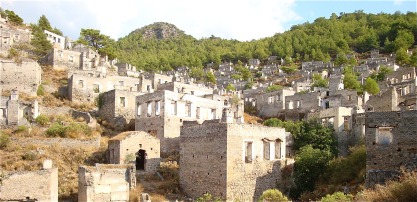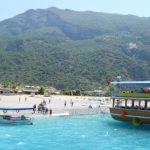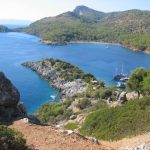Setting for “Birds Without Wings” Population: 1,000
Old name: Karmylassos, Lebessos, Levissi (Greek)
At Hisarönü/Ovacık the road from Fethiye forks, with the left forking running down to Belcekiz/Ölüdeniz and the right to Kayaköy, the town that, as the fictional Eskibahçe, provided Louis de Bernieres with the setting for his hugely popular novel, Birds Without Wings. This told the story of the Graeco-Turkish population exchange (Mübadele), a human tragedy that unfolded in the aftermath of Turkey’s War of Independence. It also featured in the film, The Water Diviner, with Russell Crowe in 2014.
As a result of the Mübadele Muslims from Greek Macedonia were sent to live in Levissi but most seem to have taken a quick look at their new “home” before saying no, thank you, and moving hastily on again. Meanwhile, their Greek counterparts established a new settlement, called Nea Levissi, near Athens.
Today the ruins of Kayaköy stand as a poignant reminder of the devastating, not always predictable toll armed conflict takes on innocent civilians.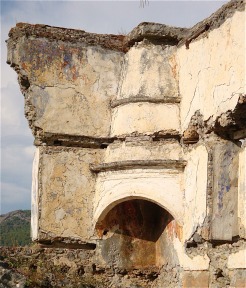
The journey from Fethiye to Kayaköy is somewhat disconcerting since, after a short run past beautiful pine forest, you pass through the extraordinary British settlement that is Hisarönü-Ovacık, built initially to safeguard lovely Ölüdeniz from any more development but then colonised by a growing battalion of expats who had decided to turn the holiday lifestyle into day-to-day reality.
Hisarönü-Ovacık’s brash full English breakfasts, Chinese takeaways and Indian curries could hardly be further removed from the ghost town that greets you in Kayaköy, where the ruins have been allowed to rest more or less in peace despite regular schemes to turn them into a holiday village.
The Lykia Yolu (Lycian Way) long-distance walking trail passes through Kayaköy.
Exploring the site
Today’s visitors find themselves facing a hillside covered in the skeletons of old greystone buildings, all of them long since robbed of wooden doors, roofs and window-frames although the stone chimneys survive intact.
After buying a ticket to visit what is now a designated museum you can follow one of the cobbled paths up into the old town, pausing as you go to listen for the ghostly voices of the men, women and children who once lived in the 400-odd houses, never dreaming that one day they would be forced to leave them.
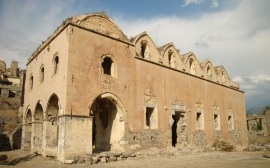 Yukarı KiliseThere are not many specific sights to track down within the ruins although if you pick up a plan you should be able to find the Yukarı Kilise (Upper Church, Taksiarkis, Church of the Archangels), with its pebble-mosaic floor, along with several tiny chapels identifiable by their apses in the main part of the site. There are also ruins of a small castle on the summit of the hill.
Yukarı KiliseThere are not many specific sights to track down within the ruins although if you pick up a plan you should be able to find the Yukarı Kilise (Upper Church, Taksiarkis, Church of the Archangels), with its pebble-mosaic floor, along with several tiny chapels identifiable by their apses in the main part of the site. There are also ruins of a small castle on the summit of the hill.
More impressive are the remains of the Asağı Kilisesi (Lower Church, Panayia Pyrgiotissa) that can be found about one km further along the road beyond the remains of the huge old schoolhouse. Here limited tourism development in the form of small gözleme-dispensing cafes and souvenir shops has been allowed to take root.
This church still retains its battered stone iconostasis as well as another pebble mosaic that was laid in 1888. Both churches were built in the 19th century when the minority populations were permitted to expand their places of worship.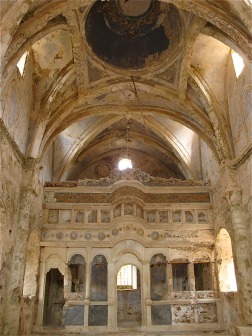 Aşağı Kilise
Aşağı Kilise
Eating
The Levissi Garden (Tel: 0252-618 0173) is a marvellous restaurant-cum-wine bar housed inside one of the old houses on the edge of the settlement. At night it offers wonderful views of the ruins, provided that you can live with uncomfortable questions about how it is that human tragedy always seems to evolve into a tourist attraction in the end.
Sleeping
The increasing number of places to stay in the vicinity of Kayaköy sell a serenity that is in complete contrast to the brasher offerings of Ölüdeniz, Hisarönü-Ovacık and Fethiye itself.
Günay’s Garden
Villa Rhapsody. Tel: 0252-618 0042
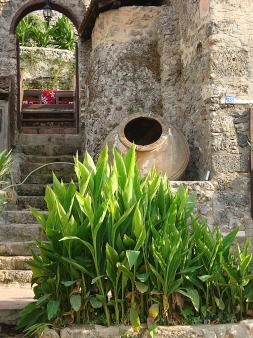 Transport info
Transport info
Kayaköy has good transport connections, with regular minibuses from Fethiye.
